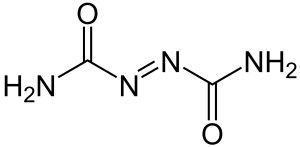Everything about Azodicarbonamide: Uses, Safety, Side effects

Production | Uses | Safety
Azodicarbonamide (ADA) is an ingredient commonly used as a whitening agent in flour and a dough conditioner in bread. However, its safety as a food additive is controversial mainly due to its application as a blowing agent in foamed plastics (e.g. yoga mats) and the side effects of semicarbazide (a breakdown product of ADA).
How is Azodicarbonamide made?

Image Source
Commercial ADA can be produced by reacting urea with hydrazine to synthesize biurea, then oxidized with hydrogen peroxide or chlorine. The following are the two steps manufacturing processes:
- N2H4·H2O + 2 OC(NH2)2→H2NC(O)-N(H)-N(H)-C(O)NH2 + 2NH3 + H2O
- H2NC(O)-N(H)-N(H)-C(O)NH2 + H2O2→H2NCON=NCONH2 + 2H2O OR H2NC(O)-N(H)-N(H)-C(O)NH2 + Cl2→H2NC(O)-N=N-C(O)NH2 + 2HCl
Specification
| Appearance | A yellow to orange-red, odorless crystalline powder |
| Other names | Azodicarboxamide, Azobisformamide |
| CAS number | 123-77-3 |
| Chemical formula | C2H4O2N4 |
| Molecular weight | 116.08 |
| Solubility | Insoluble in water and most organic solvents, easily soluble in dimethyl sulfoxide and N,N-dimethylformamide. |
What’re the Uses of Azodicarbonamide?
Food grade ADA is used for the purpose of making flour white and strengthening dough in bread. Due to the functions of bleaching and oxidation, azodicarbonamide is a fast-acting gluten enhancer that strengthens the elasticity and toughness of gluten, and makes a high-strength dough. It works immediately even if the flour is wet.
Potassium bromate substitute
Other dough conditioners include potassium bromate, potassium iodate, ascorbic acid, and calcium peroxide. In previous years, one of the most commonly used dough conditioners was potassium bromate in the market. However, due to its toxicity and cancer-caused dangers, it was banned in most countries but is still approved by the FDA.
It is classified in “Group 2B” means “possibly carcinogenic to humans” by the International Agency for Research on Cancer (IARC). (1)
Azodicarbonamide was used to safely replace potassium bromate in the bakery as a flour maturing agent by the FDA since 1962.
With the ability to achieve rapid oxidation at low use levels, azodicarbonamide is an ideal replacement of potassium bromate in flour treatment and baked goods.
Dough conditioner
In the production of bakery products, oxidants (such as azodicarbonamide) are often added to enhance the elasticity & toughness of gluten, and improve the properties of rheological and mechanical processing of dough, so that the bakery products can have a larger volume and a softer texture.
Whitening agent
Pigments (such as carotene, lutein and other plant pigments) naturally present in flour may make the flour grey and the adding of azodicarbonamide can oxidize such pigments and thus make the product white.
How does ADA work?
Azodicarbonamide itself almost does not work with flour, but when mixed with flour and water to form a dough, it quickly releases active oxygen and oxidizes the sulfhydryl groups of amino acids to disulfide bonds in the molecule of protein. Therefore it improves the elasticity, toughness and uniformity of the dough.
Noodles produced with azodicarbonamide are smooth, soft, white, and resistant to boiling. Flour with low protein and low gluten content requires an efficient and low-cost dough conditioner.
Blowing agent
Azodicarbonamide can also act as a general-purpose blowing agent in the industrial production of rubber and plastics, such as polyvinyl chloride, polyethylene, polypropylene, polystyrene, and other synthetic materials.
Azodicarbonamide can be used to manufacture rubber soles, artificial leather and yoga mates as it decomposes to gases of carbon monoxide, carbon dioxide, nitrogen and ammonia which are trapped in the form of tiny bubbles in the polymer during the production process of above industrial uses, that increases the elasticity and strength of the product and makes them in a foamed state.
Is Azodicarbonamide Safe to Eat?
ADA is a controversial ingredient, which is approved by the FDA and JECFA, but not permitted by the EFSA, Food Standards Australia New Zealand and some other authorities.
Some people are afraid of it as it is a “yoga mat chemical” and the possible side effects of semicarbazide, although it is listed as “not classifiable as to its carcinogenicity to humans” by the International Agency for Research on Cancer.
Food Babe (a food blog) initially drew public attention to the stop use of azodicarbonamide in bread for it was also a chemical used in shoe rubbers and yoga mats, and may be associated with the health issues (e.g. respiratory problems, allergies and asthma) (2)
The blog listed several fast food companies using azodicarbonamide in its bread, such as Subway, Mcdonald’s, Starbucks and so on. (3)
To make consumers not worry about the safety of their bread products, Subway removed it in their bread soon (4). ADA is still in Mcdonald’s bread. (5)
FDA
Azodicarbonamide may be safely used as an aging & bleaching ingredient in cereal flour and a dough conditioner in bread baking with the maximum level 0.0045%. (6)
EFSA
Azodicarbonamide is not permitted as a food additive in Europe, but previously with the European food additive number E927a. Due to the carcinogenicity and genotoxicity caused by semicarbazide, EFSA also been banned it as a blowing agent in food contact materials since August 2005. (7).
JECFA
Function Class: food additives, flour treatment agent. (8)
Usage: “0-45 mg/kg in flour treatment” set in 1965. (9)
Conclusion
Now you may have a knowledge of azodicarbonamide, from the following aspects:
- Manufacturing process
- Uses as a whitening agent, dough conditioner and blowing agent
- Approved safety
- Side effects and where it comes from
If you have any questions or remarks about this additive, feel free to let me know in the comments.

use of Azodicarbonamide in bakery.
use of Azodicarbonamid in bakry.